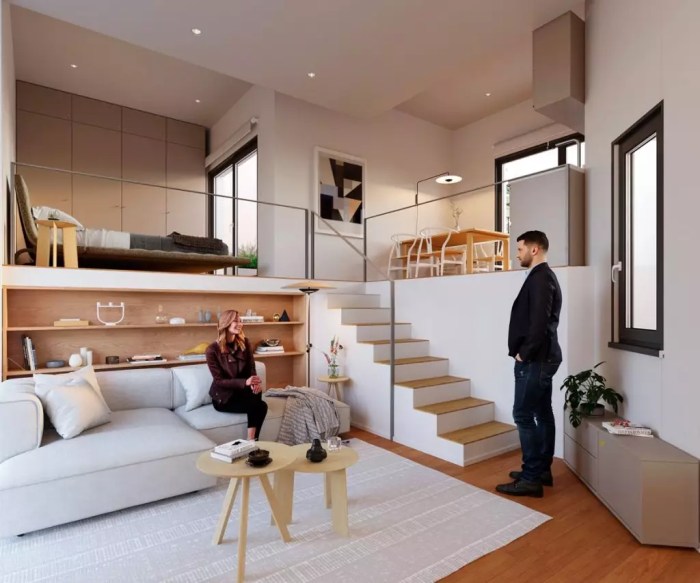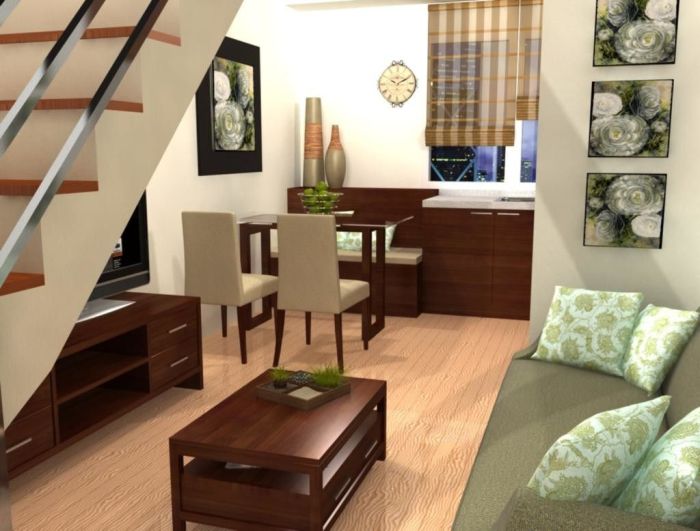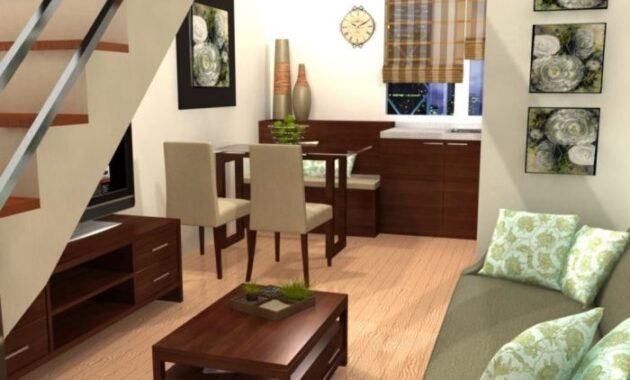American small house interior design embraces the challenge of creating stylish and functional living spaces within a compact footprint. This design approach prioritizes maximizing space, incorporating smart storage solutions, and selecting furniture that serves multiple purposes. It’s about creating a sense of spaciousness and flow, even in limited square footage, while reflecting the unique character and personality of the homeowner.
From minimalist aesthetics to farmhouse charm, various interior design styles can be adapted to small houses, each offering its own unique blend of colors, textures, and materials. The key is to create a cohesive and inviting atmosphere that feels both cozy and welcoming.
Natural light plays a crucial role in enhancing the sense of space and brightening the interiors. This guide explores practical tips, design strategies, and inspirational examples to help you transform your small house into a haven of comfort and style.
Space Optimization and Functionality

Living in a small house presents unique challenges, but it also offers an opportunity to be creative with space and design. By embracing smart solutions and maximizing every inch, you can create a functional and comfortable home that feels larger than it actually is.
Furniture Selection for Small Spaces
Choosing the right furniture is crucial for maximizing space in a small house. Opt for multi-functional pieces that serve multiple purposes. For instance, a sofa bed can double as a guest bed, a coffee table with storage can keep clutter at bay, and a dining table that folds away can free up space when not in use.
- Consider Furniture with Built-in Storage:Look for pieces like ottomans with hidden compartments, beds with drawers underneath, or shelves integrated into the furniture design. This maximizes storage while minimizing the need for additional furniture.
- Prioritize Scale and Proportion:Select furniture that is appropriately sized for the room. Oversized furniture can make a small space feel cramped, while too much small furniture can create a cluttered look. Aim for a balance that creates a sense of spaciousness.
- Utilize Vertical Space:Don’t neglect vertical space. Tall bookcases, shelves, and cabinets can store items efficiently while keeping them off the floor, creating a sense of openness.
Storage Solutions for a Small House
Efficient storage is key to keeping a small house organized and clutter-free. Consider implementing a variety of storage solutions throughout the home.
- Maximize Wall Space:Install shelves, mirrors, and wall-mounted organizers to maximize vertical space and minimize the footprint of freestanding furniture.
- Utilize Under-Bed Storage:Utilize under-bed storage containers or drawers to store seasonal items, extra bedding, or other items that are not used frequently.
- Embrace Open Shelving:Open shelving can add visual interest and make a small space feel less cluttered. Choose shelves that are proportionate to the room size and avoid overfilling them.
Multi-Purpose Room Design
In a small house, every room needs to be functional and versatile. Consider designing rooms with multiple uses in mind.
- Living Room/Office Combo:Create a dedicated workspace within the living room by using a desk that can be folded away or a built-in desk with storage. This allows for both relaxation and work within the same space.
- Dining Room/Guest Room:A dining table with a pull-out bed or a Murphy bed can create a versatile space that can be used for both dining and sleeping. This is a great solution for homes with limited guest space.
- Kitchen/Breakfast Nook:Design a small breakfast nook within the kitchen for casual meals. This allows for a separate dining area without taking up valuable space in a separate room.
Creating a Sense of Spaciousness
While small spaces can be challenging, there are design strategies that can make them feel larger.
- Use Light Colors:Light colors, such as white, cream, and pastels, reflect light and create a sense of openness. Avoid using dark colors, which can make a space feel smaller and more cramped.
- Incorporate Mirrors:Mirrors strategically placed can reflect light and create the illusion of more space. Consider placing mirrors opposite windows or in hallways to maximize the reflection of natural light.
- Minimize Clutter:A clutter-free space always feels more spacious. Regularly declutter and store items in designated areas to avoid creating visual noise.
- Choose Light and airy Fabrics:Lightweight curtains and fabrics can make a space feel more airy and less cluttered. Avoid heavy drapes or furniture covers that can make a room feel cramped.
Small House Kitchen Design
Designing a small kitchen that is both functional and aesthetically pleasing requires careful planning.
- Optimize Layout:A galley kitchen layout is ideal for small spaces. This layout maximizes wall space and creates a streamlined flow. Consider incorporating a kitchen island for additional counter space and storage.
- Maximize Vertical Space:Utilize cabinets that extend to the ceiling to maximize storage space. Consider installing shelves above cabinets for additional storage.
- Choose Compact Appliances:Opt for compact appliances like a countertop dishwasher, a mini-fridge, or a smaller oven. These appliances save space without compromising functionality.
- Use Open Shelving:Open shelving can create a sense of spaciousness in a small kitchen. Use baskets or containers to organize items and create a cohesive look.
Interior Design Styles and Trends

Creating a visually appealing and functional interior is crucial, especially in small houses where space is limited. By embracing popular design styles, incorporating trendy elements, and prioritizing functionality, you can transform your small house into a stylish and comfortable home.
Popular Interior Design Styles for Small Houses
Selecting the right interior design style can significantly impact the overall feel and functionality of your small house. Here are some popular styles that are well-suited for limited spaces:
- Minimalist:This style emphasizes simplicity, clean lines, and a neutral color palette. It focuses on maximizing space by using essential furniture and minimizing clutter. Minimalist design is perfect for small houses as it creates a sense of spaciousness and tranquility.
- Scandinavian:Characterized by its light and airy atmosphere, Scandinavian design utilizes natural materials like wood, wool, and linen. It features a muted color palette with accents of bright colors and emphasizes functionality and practicality. This style is ideal for small houses as it brings a sense of warmth and sophistication while promoting functionality.
- Farmhouse:This style embraces rustic charm and natural elements, creating a cozy and inviting atmosphere. It often features warm wood tones, distressed finishes, and vintage accents. Farmhouse design can be adapted for small houses by using lighter wood tones and incorporating built-in storage solutions to maximize space.
- Industrial:This style combines raw materials like metal, concrete, and exposed brick with vintage industrial elements like pipes and lighting fixtures. It creates a modern and edgy feel while promoting a sense of spaciousness due to its open floor plan and minimal ornamentation.
This style is well-suited for small houses with high ceilings and exposed beams.
Color Palettes, Materials, and Textures
Choosing the right color palette, materials, and textures can enhance the visual appeal and functionality of your small house. Here are some tips for creating a cohesive and inviting atmosphere:
- Color Palettes:Light and neutral colors like white, gray, and beige create a sense of spaciousness and make a small space feel larger. Incorporating pops of color through accent furniture, artwork, or throw pillows can add visual interest and personality.
- Materials:Natural materials like wood, stone, and linen bring warmth and texture to a small space. Using reflective surfaces like mirrors and glass can also create an illusion of more space.
- Textures:Mixing textures can add depth and visual interest to a small house. For example, combining a smooth leather sofa with a textured rug or a sleek metal coffee table with a soft throw blanket creates a balanced and inviting atmosphere.
Current Trends in Small House Interior Design, American small house interior design
Small house interior design is constantly evolving, incorporating new trends and technologies. Here are some current trends that are transforming the way people live in small spaces:
- Natural Elements:Bringing the outdoors in is a popular trend in small house interior design. Incorporating plants, natural light, and organic materials creates a sense of tranquility and connection to nature.
- Sustainable Materials:As environmental awareness grows, using sustainable materials like bamboo, cork, and recycled materials is becoming increasingly popular. These materials are eco-friendly and often have unique textures and colors that enhance the overall design aesthetic.
- Smart Home Technology:Smart home technology is making its way into small houses, offering convenience and efficiency. Features like voice-controlled lighting, automated thermostats, and smart appliances can streamline daily tasks and create a more comfortable living environment.
Creating a Sense of Coziness
A small house can be a haven of comfort and warmth, but it requires careful attention to detail to create a cozy and inviting atmosphere. By incorporating design elements that emphasize softness, warmth, and personal touches, you can transform a compact space into a sanctuary where you can relax and unwind.
The Role of Textiles
Textiles play a crucial role in creating a sense of warmth and comfort in a small house. Rugs, throws, and curtains can add texture, color, and a touch of personality to the space.
- Rugs:Area rugs define spaces and add warmth to floors. Choose rugs with soft textures, such as wool, cotton, or chenille, in colors that complement the overall color scheme of the room. A large rug can make a small room feel more spacious, while smaller rugs can be used to create distinct zones within a single space.
- Throws:Throws are perfect for adding a pop of color and texture to furniture, such as sofas, chairs, and beds. They provide an extra layer of warmth and comfort, making your home feel more inviting. Choose throws in materials like fleece, wool, or faux fur, in colors and patterns that match your personal style.
- Curtains:Curtains can soften the edges of windows and add a touch of elegance to a small house. Opt for curtains in heavier fabrics, such as velvet, linen, or cotton, in warm colors or patterns that complement the walls and furniture.
Consider using curtains with blackout lining to create a more intimate and cozy atmosphere.
Incorporating Personal Touches
Adding personal touches to your small house interior design can make it feel more like home. These can include sentimental items, family photos, artwork, or travel souvenirs.
- Sentimental Items:Incorporate items that hold special meaning to you, such as heirlooms, family photos, or mementos from travels. Display them on shelves, walls, or in glass cabinets. These items can add a touch of nostalgia and personality to your home.
- Family Photos:Create a gallery wall of family photos in various sizes and frames. This can add a personal touch and create a warm and welcoming atmosphere. Arrange photos in a grid pattern, a collage, or a more free-flowing arrangement.
- Artwork:Display artwork that you love, whether it’s paintings, prints, or sculptures. Choose pieces that reflect your personal style and complement the overall color scheme of your home. You can hang artwork on walls, place it on shelves, or use it as a centerpiece on a coffee table.
- Travel Souvenirs:Bring back souvenirs from your travels and display them in your home. This can add a touch of adventure and personality to your space. For example, you could display a collection of seashells from a beach vacation, a map of a city you visited, or a piece of pottery from a local artisan.
Case Studies and Inspiration

Seeing how other homeowners have successfully navigated the challenges of small space living can provide invaluable inspiration for your own design project. These case studies showcase how to maximize functionality, embrace style, and create a cozy and inviting atmosphere in a compact home.
Examples of Well-Designed American Small Houses
These examples demonstrate how to make the most of limited square footage while maintaining a sense of spaciousness and style.
| House Size | Location | Interior Design Style | Key Features |
|---|---|---|---|
| 800 square feet | Portland, Oregon | Modern Farmhouse | Open floor plan, built-in storage, light-filled living spaces, a small, efficient kitchen |
| 650 square feet | Los Angeles, California | Mid-Century Modern | Sleek lines, minimalist decor, a focus on natural light, a multi-functional dining area |
| 750 square feet | Austin, Texas | Industrial Chic | Exposed brick, metal accents, reclaimed wood elements, a loft-style bedroom |
Challenges and Solutions: American Small House Interior Design
Designing a small house interior can be a rewarding yet challenging endeavor. Limited space, budget constraints, and the need to balance functionality and aesthetics are common hurdles. However, with thoughtful planning and creative solutions, these challenges can be transformed into opportunities to create a beautiful and functional living space.
Addressing Space Constraints
Small houses present unique challenges in maximizing space. The key is to utilize every inch wisely. Here are some effective strategies:
- Multi-Functional Furniture: Invest in pieces that serve multiple purposes. For instance, a sofa bed can transform into a sleeping area, while a coffee table with storage can double as a functional storage solution.
- Vertical Storage: Maximize vertical space by utilizing shelves, cabinets, and wall-mounted organizers. This allows for efficient storage without sacrificing floor space.
- Mirrors: Strategically placed mirrors can create the illusion of larger spaces by reflecting light and expanding the visual field.
- Light Colors: Light colors on walls and furniture can make a room appear more spacious. Avoid using dark colors that can make a small space feel cramped.
Managing Budget Constraints
Budget limitations are a common concern for homeowners. Fortunately, there are many ways to design a stylish and functional interior without breaking the bank.
- Prioritize Key Areas: Focus on investing in key areas like the kitchen or living room, where you spend the most time. You can save on other areas by opting for more budget-friendly solutions.
- DIY Projects: Embrace DIY projects to personalize your space and save money. This could involve painting furniture, creating wall art, or building simple storage solutions.
- Secondhand Furniture: Explore local antique shops, flea markets, or online marketplaces for unique and affordable furniture pieces.
- Shop Around for Deals: Compare prices from different retailers and look for sales and discounts. Consider purchasing furniture during off-season or end-of-season sales.
Balancing Functionality and Aesthetics
A small house interior should be both functional and aesthetically pleasing. Here are some tips to achieve this balance:
- Open Floor Plan: An open floor plan can create a sense of spaciousness and flow, connecting different areas without feeling cramped.
- Minimalist Design: Embrace a minimalist aesthetic with clean lines, simple furniture, and limited clutter. This approach maximizes space and creates a sense of calm.
- Storage Solutions: Invest in efficient storage solutions to keep clutter at bay. This could include built-in cabinets, drawers, or under-bed storage.
- Natural Light: Maximize natural light by using light-colored curtains or blinds and keeping windows unobstructed.
Planning a Small House Interior Design Project
A checklist can help ensure a smooth and successful design process. Consider the following:
- Define Your Needs and Lifestyle: Consider your family’s needs, activities, and lifestyle preferences. This will help guide your design choices.
- Set a Budget: Establish a realistic budget for the project, factoring in materials, furniture, labor, and unexpected expenses.
- Create a Mood Board: Gather images and ideas that inspire you. This will help you visualize the desired look and feel of your space.
- Measure Your Space: Accurately measure all rooms and areas to ensure furniture and fixtures fit properly.
- Plan Storage Solutions: Consider storage needs for each room and plan accordingly, maximizing efficiency and minimizing clutter.
- Choose a Color Palette: Select a color palette that complements your style and creates the desired mood and atmosphere.
- Seek Professional Advice: If needed, consult with an interior designer or architect for expert guidance and advice.
Final Summary
Designing an American small house interior is a balancing act between functionality and aesthetics. It’s about embracing the challenges of limited space and maximizing every inch to create a home that feels both comfortable and stylish. By incorporating smart design solutions, embracing versatile furniture, and prioritizing natural light, you can create a small house that feels spacious, inviting, and uniquely yours.
FAQs
What are some common challenges faced when designing small house interiors?
Common challenges include limited space, budget constraints, and the need to balance functionality and aesthetics. It’s important to consider the specific needs and preferences of the homeowner while maximizing every inch of space.
How can I create a sense of spaciousness in a small house?
Utilize light colors, reflective surfaces, and strategically placed mirrors to visually expand the space. Keep furniture scaled appropriately and choose pieces that serve multiple purposes. Incorporate open shelving and avoid bulky furniture to create a sense of openness.
What are some popular interior design styles that work well for small houses?
Minimalist, Scandinavian, farmhouse, and industrial styles are often favored for small houses. These styles prioritize clean lines, light colors, and a focus on functionality, making them ideal for creating a sense of spaciousness and order.
How can I incorporate sustainable design elements into my small house interior?
Choose eco-friendly materials, such as reclaimed wood or bamboo. Opt for energy-efficient appliances and lighting fixtures. Incorporate green building materials and water-saving fixtures to minimize your environmental impact.

